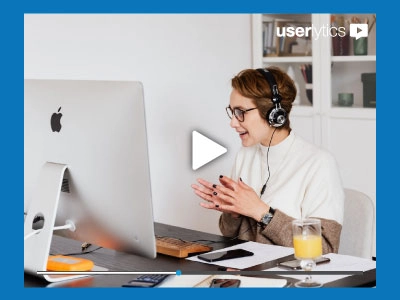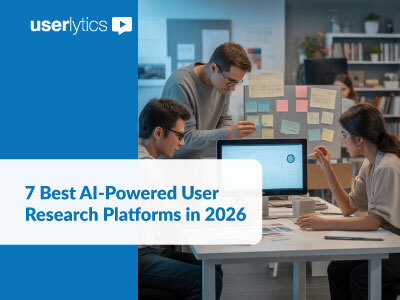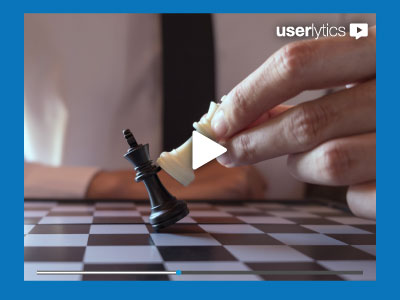Unlock the power of effective remote session moderation
Ready to take your remote session moderation skills to the next level? Join us for an illuminating webinar, “How to Moderate Remote Sessions,” hosted by Userlytics. In this webinar, we’ll guide you through the essential techniques and strategies for conducting engaging and insightful remote sessions.
Whether you’re a UX researcher, designer, product manager, or anyone involved in moderating user sessions, this webinar will equip you with the knowledge and skills needed to excel in remote moderation and derive meaningful user insights.
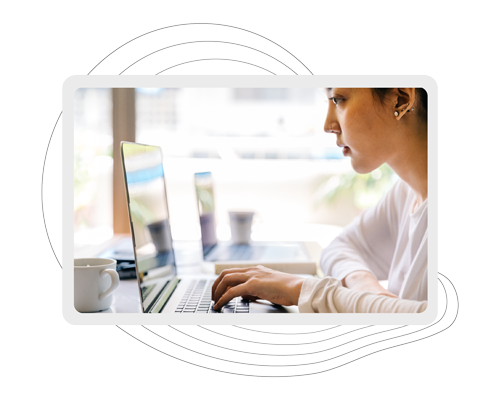
Benefits and takeaways
- Gain a deep understanding of the principles behind effective remote session moderation and how to create a comfortable and productive virtual environment.
- Learn proven strategies for structuring and guiding remote sessions to uncover valuable user feedback and insights.
- Discover techniques to establish rapport with participants remotely, fostering engagement and authentic responses.
- Explore best practices for asking effective questions, probing for insights, and capturing valuable user feedback.
- Acquire practical tips for managing technical challenges during remote sessions and ensuring smooth interactions.
- Uncover the art of active listening and observation in remote sessions to derive nuanced user insights.
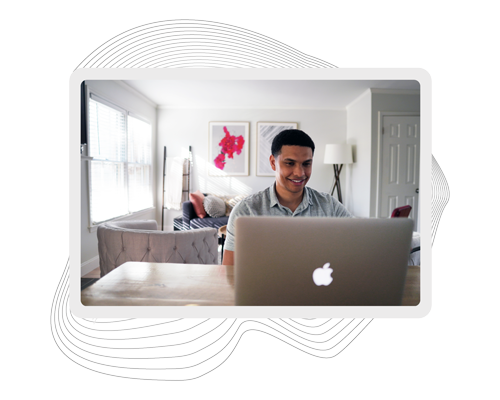
Who is it for?
This webinar is tailored for UX researchers, designers, product managers, and anyone involved in moderating remote user sessions. Whether you’re a seasoned professional or just starting your journey, this webinar will provide valuable insights to enhance your remote moderation skills and drive impactful user research.
In particular:
- User Experience Researchers
- B2B SaaS Vendors
- Marketing Executives
- User Experience Designers
- Product Managers
- User Experience Writers
WHAT WILL YOU LEARN?
- Understand the unique dynamics of remote session moderation and how it differs from in-person moderation.
- Learn how to effectively plan and prepare for remote sessions, including setting clear objectives and designing discussion guides.
- Discover techniques for building rapport and establishing a comfortable environment for participants in virtual settings.
- Explore various approaches to moderating remote sessions, including usability testing, interviews, focus groups, and more.
Userlytics

Since 2009 we have been helping enterprises, governmental organizations, non-profits, agencies and startups optimize their user experience, or UX. With our state-of-the-art platform, massive global participant panel and unlimited accounts/seats for democratizing user research, we are the best all-in-one solution for remote user testing.
Schedule a Free DemoModerating remote sessions for user research or usability testing can be done effectively with the right tools and techniques. Here are some tips to help you moderate remote sessions: Choose the right remote research tool: Select a reliable remote research tool that allows you to conduct sessions with participants remotely. Userlytics is one such tool that provides features for remote usability testing, including screen sharing, video recording, and task assignments. Set up the technology: Ensure that you and the participants have the necessary technology set up for the remote session. This includes a stable internet connection, a webcam, and a microphone. Familiarize yourself with the remote research tool’s features and test them before the session to avoid any technical issues.
Prepare your participants: Send out clear instructions and guidelines to participants before the session. Provide them with any necessary pre-session tasks or materials. Make sure they understand how to use the remote research tool and are prepared for the session. Establish rapport and introduce the session: Begin the session by introducing yourself and building rapport with the participant. Explain the purpose of the session and let them know what to expect. Provide a brief overview of the research objectives and any specific tasks or scenarios they will be asked to complete.Clearly communicate instructions: When giving instructions for tasks or activities, be clear a
nd concise. Break down complex tasks into smaller, manageable steps. Use simple language and avoid jargon. Allow participants to ask questions if they need clarification. Actively listen and observe: As the session progresses, actively listen to the participant’s feedback and observations. Encourage them to think aloud and share their thoughts as they complete tasks. Pay attention to both verbal and non-verbal cues to gain deeper insights into their experience.Ask probing questions: Use follow-up questions to delve deeper into the participant’s thought process and understanding. Ask open-ended questions that encourage them to share their opinions, preferences, and challenges. This helps uncover valuable insights that may not surface through task completion alone.
Remain neutral and unbiased: As a moderator, strive to maintain a neutral and unbiased stance. Avoid leading the participant or influencing their responses. This ensures that their feedback is genuine and unbiased, providing more accurate insights. Take notes: Document important observations, key insights, and notable quotes during the session. These notes will help you during the analysis and reporting stages. Userlytics provides features for taking timestamped notes and annotations during the remote session. Wrap up and debrief: At the end of the session, thank the participant for their time and participation. Give them an opportunity to ask questions or provide additional feedback. Provide a brief summary of the session and any next steps, if applicable. Moderating remote sessions requires effective communication, technical proficiency, and adaptability. By following these tips and leveraging the features of Userlytics or similar remote research tools, you can conduct successful and insightful remote sessions for user research or usability testing.
